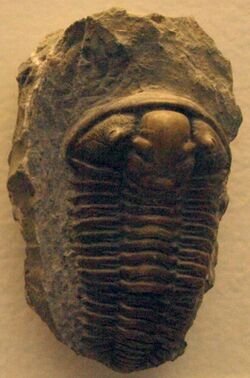Biology:Calymene blumenbachii
| Calymene blumenbachii | |
|---|---|

| |
| Calymene blumenbachii, on display at the Natural History Museum, London | |
| Scientific classification | |
| Domain: | Eukaryota |
| Kingdom: | Animalia |
| Phylum: | Arthropoda |
| Class: | †Trilobita |
| Order: | †Phacopida |
| Family: | †Calymenidae |
| Genus: | †Calymene |
| Species: | †C. blumenbachii
|
| Binomial name | |
| †Calymene blumenbachii Brongniart in Desmarest, 1817
| |
File:“Fig 4” - Calymene blumenbachii - - Print - Iconographia Zoologica - Special Collections University of Amsterdam - UBAINV0274 099 01 0002 (cropped).tif File:Calymene blumenbachii - - Print - Iconographia Zoologica - Special Collections University of Amsterdam - UBAINV0274 099 01 0003 (cropped).tif Calymene blumenbachii Brongniart in Desmarest (1817),[1] sometimes erroneously spelled blumenbachi, is a species of trilobite discovered in the limestone quarries of the Wren's Nest in Dudley, England. Nicknamed the Dudley Bug or Dudley Locust[2] by 18th-century quarrymen it became a symbol of the town and featured on the Dudley County Borough Council coat-of-arms. Calymene blumenbachii is commonly found in Silurian rocks (422.5–427.5 million years ago) and is thought to have lived in the shallow waters of the Silurian, in low-energy reefs. This particular species of Calymene (a fairly common genus in the Ordovician-Silurian) is unique to the Wenlock series in England, and comes from the Wenlock Limestone Formation in Much Wenlock and the Wren's Nest in Dudley. These sites seem to yield trilobites more readily than any other areas on the Wenlock Edge, and the rock here is dark grey as opposed to yellowish or whitish as it appears on other parts of the Edge, just a few miles away, in Church Stretton and elsewhere. This suggests local changes in the environment in which the rock was deposited.
References
- ↑ Desmarest, A. G. 1817. Calymène. in: Nouveau Dictionnaire d'Histoire Naturelle, Nouvelle Edition, Tome 8, pp. 517 - 518.
- ↑ Alex J. Chestnut. "Using morphometrics, phylogenetic systematics and parsimony analysis to gain insight into the evolutionary affinities of the Calymenidae Trilobita". OhioLINK ETD Center. http://etd.ohiolink.edu/view.cgi?acc_num=wright1239724101. Retrieved August 21, 2011.
External links
- Dudley County Borough Council coat-of-arms at Civic Heraldry
- Wren's Nest at bbc.co.uk
- Siveter, Derek J.. "The type species of Calymene (Trilobita) from the Silurian of Dudley, England". Palaeontology 28 (4): 783–792. https://www.palass.org/publications/palaeontology-journal/archive/28/4/article_pp783-792.
- Donald G. Mikulic & Joanne Kluessendorf, 2007: The legacy of the locust—Dudley and its famous trilobite Calymene blumenbachii. In: D. G. Mikulic, et al., editors. Fabulous Fossils, 300 years of worldwide research on trilobites. New York State Museum Bulletin 507, p. 141-170. https://web.archive.org/web/20140714172533/http://www.nysm.nysed.gov/staffpubs/docs/16439.pdf
Wikidata ☰ Q5024647 entry
 |

